Abstract
BACKGROUND: Previous studies of the effects of passive exposure to smoke on spirometric indices in children have largely relied on questionnaire measures of exposure. This may have resulted in underestimation of the true effect of passive smoking. Biochemical measures offer the opportunity to estimate recent exposure directly. METHODS: The relation between spirometric indices and passive exposure to tobacco smoke was examined in a large population sample of 5-7 year old children from 10 towns in England and Wales. The effects of passive exposure to smoke on lung function were assessed by means of both salivary cotinine concentration and questionnaire measurements of exposure. Analyses of the relation between spirometric values and cotinine concentrations were based on 2511 children and of the relation between spirometric values and questionnaire measures on 2000 children. RESULTS: Cotinine concentration was negatively associated with all spirometric indices after adjustment for confounding variables, which included age, sex, body size, and social class. The strongest association was with mid expiratory flow rate (FEF50), the fall between the bottom and top fifths of the cotinine distribution being 6%, equivalent to a reduction of 14.3 (95% confidence limits (CL) 8.6, 20.0) ml/s per ng/ml cotinine. Salivary cotinine concentrations were strongly related to exposure to cigarette smoke at home but 88% of children who were from non-smoking households and not looked after by a smoker had detectable cotinine concentrations, 5% being in the top two fifths of the cotinine distribution. A composite questionnaire score based on the number of regular sources of exposure was as strongly related to mid and end expiratory flow rates as the single cotinine measure. The fall in FEF50 per smoker to whom the child was exposed was 51.0 (26.5, 75.5) ml/s. The relationships between the questionnaire score and forced vital capacity (FVC) or forced expiratory volume in one second (FEV1) were not statistically significant. CONCLUSIONS: These effects of passive smoking on respiratory function are consistent with the results of previous studies and, although small in absolute magnitude, may be important if the effects of exposure are cumulative. In children aged 5-7 years the use of a single salivary cotinine concentration as a marker of passive exposure to smoke resulted in clear relationships between exposure and FVC and FEV1, whereas the associations were much weaker and not significant when based on the questionnaire score. The associations between exposure and mid or end expiratory flow rates were of similar magnitude for cotinine concentration and the questionnaire score. The use of salivary cotinine concentration in longitudinal studies may help to determine the extent to which these effects are cumulative or reversible.
Full text
PDF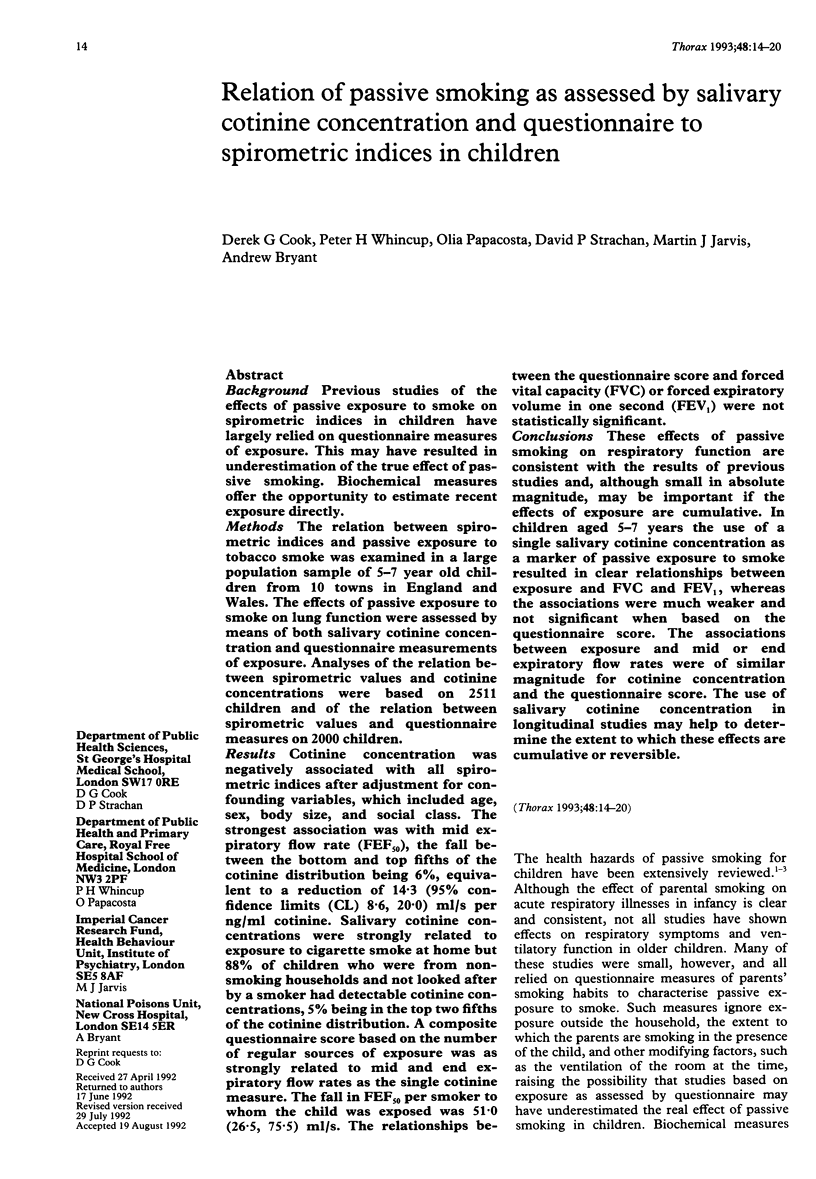
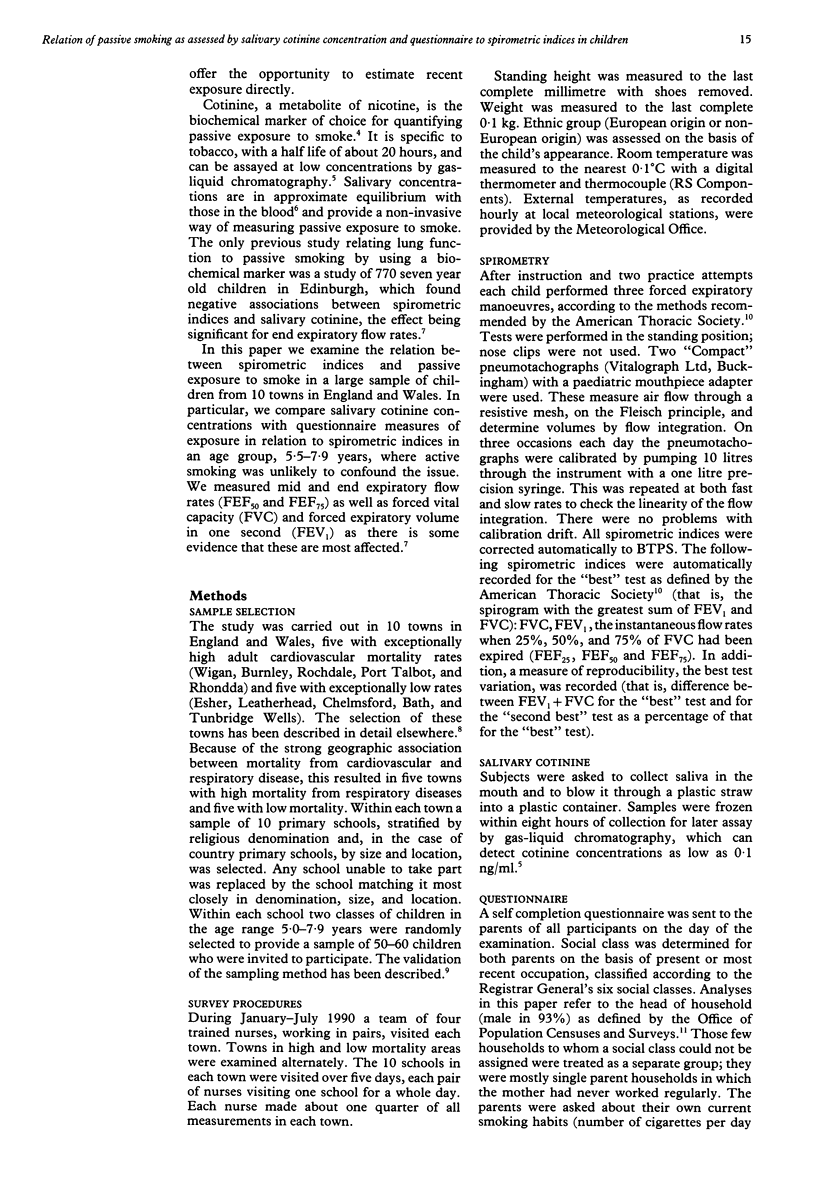
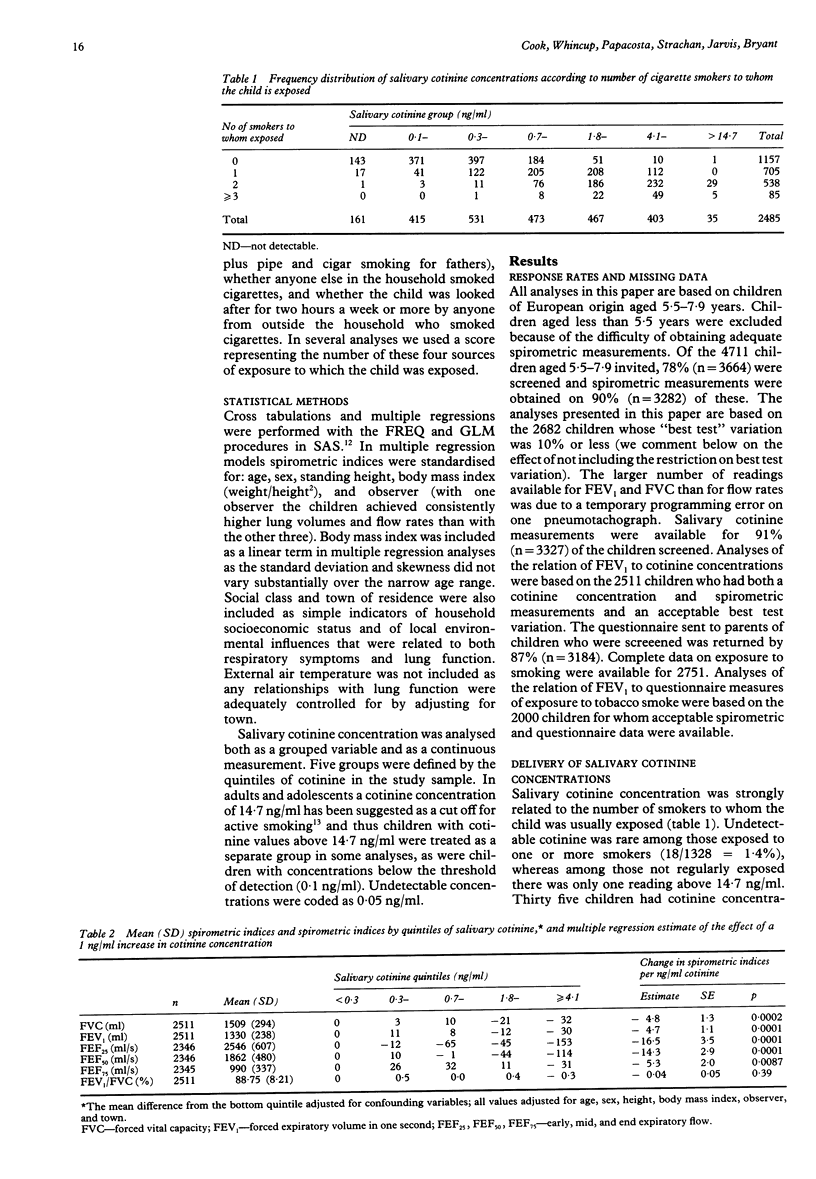
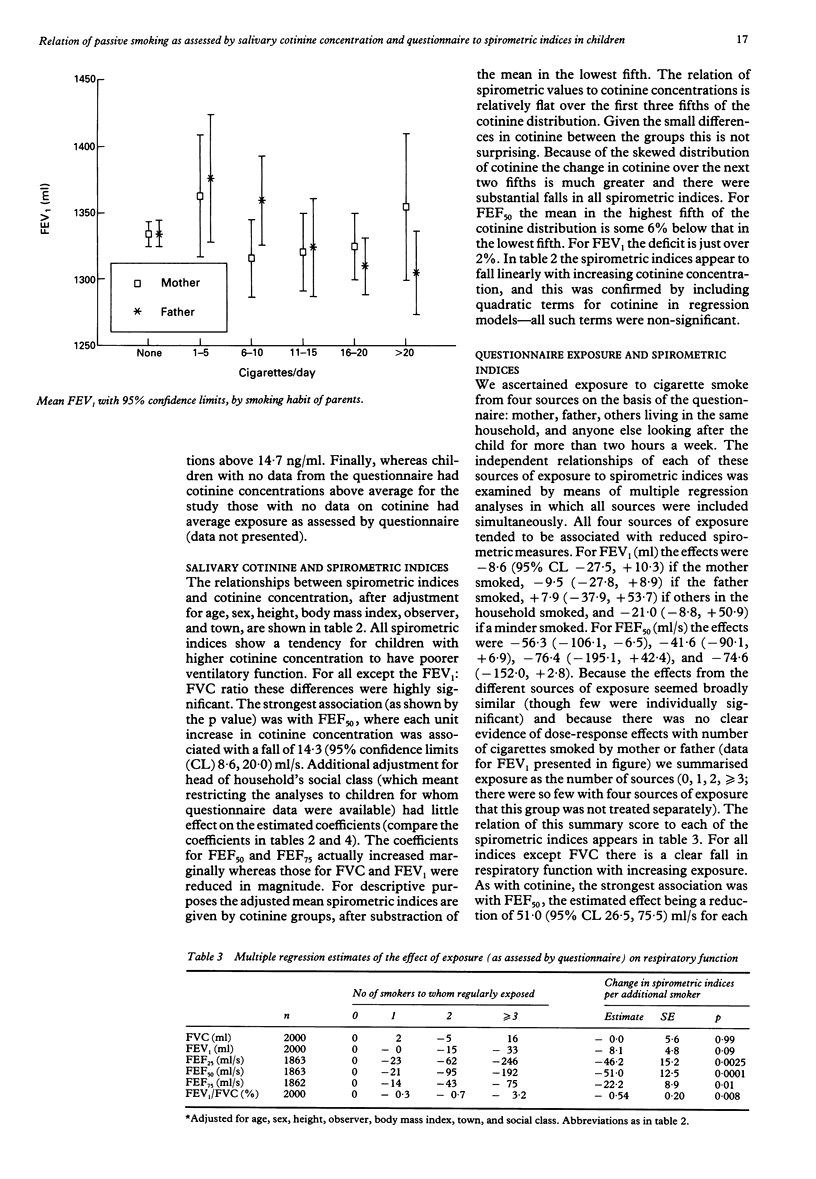
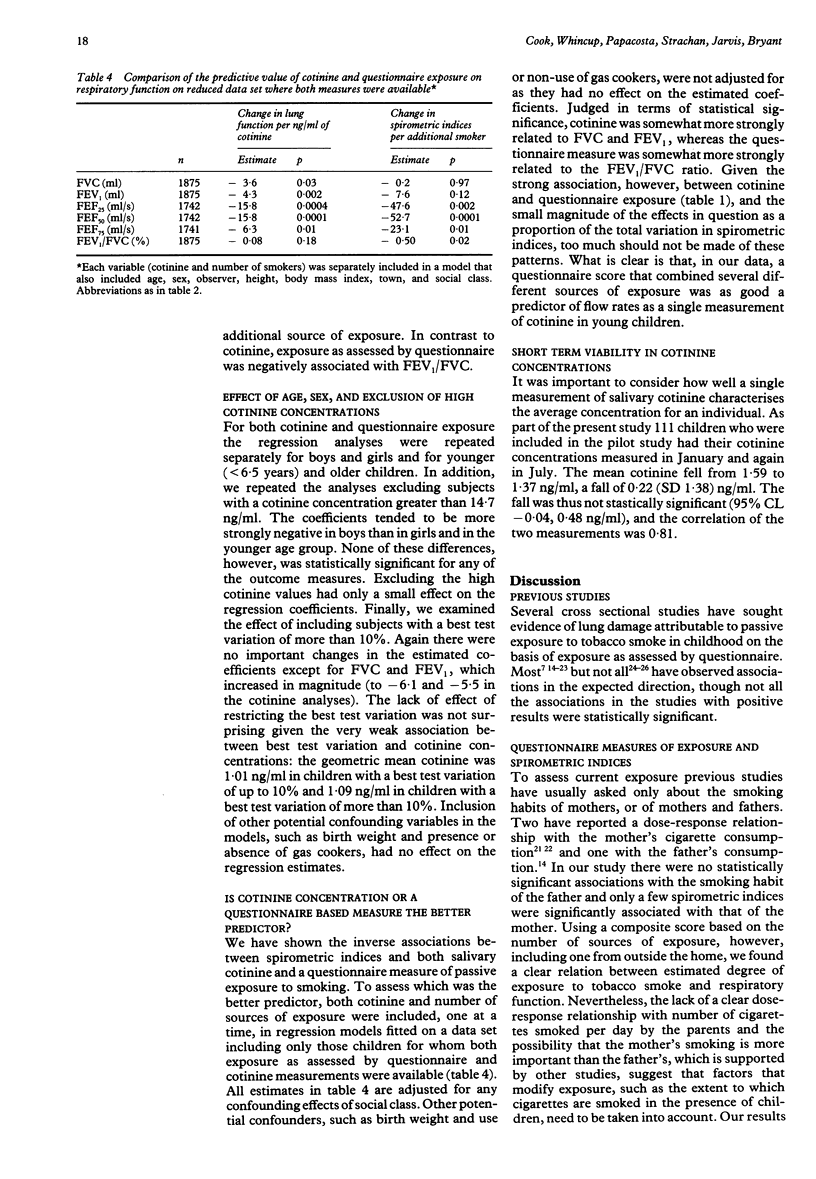
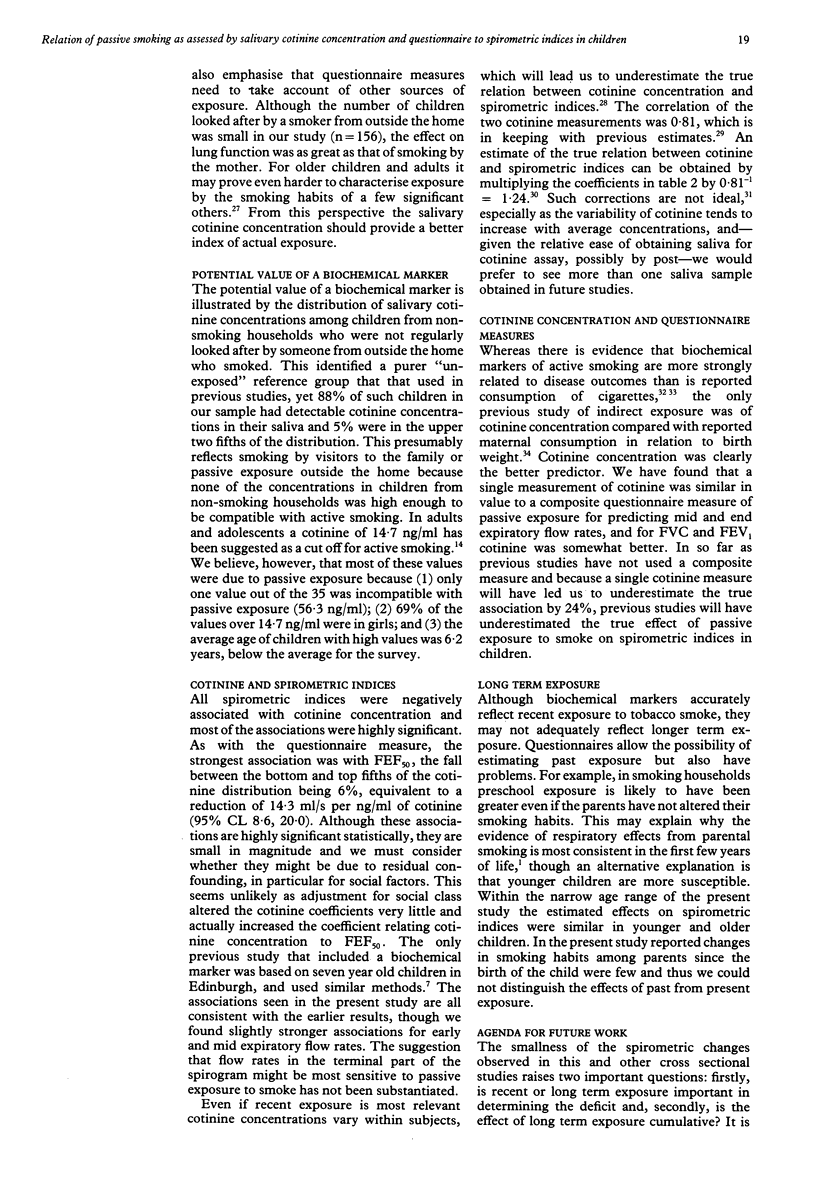
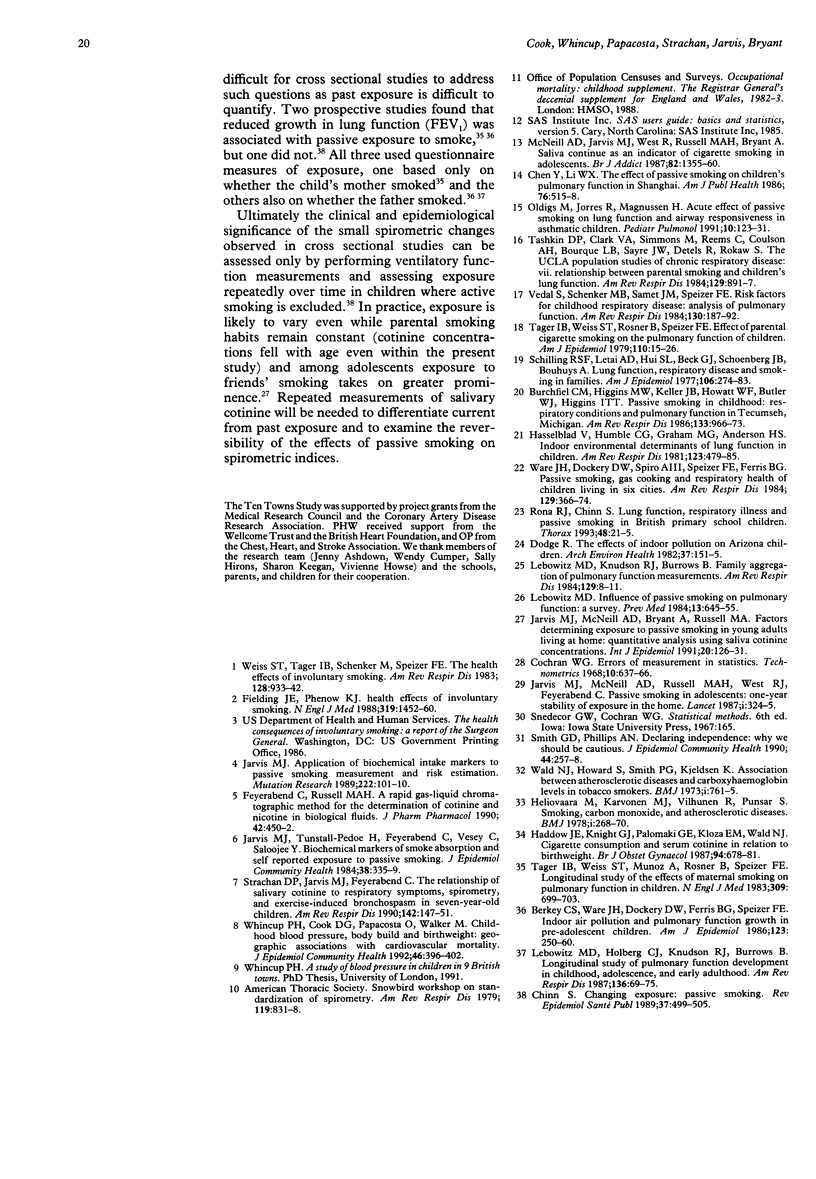
Selected References
These references are in PubMed. This may not be the complete list of references from this article.
- Berkey C. S., Ware J. H., Dockery D. W., Ferris B. G., Jr, Speizer F. E. Indoor air pollution and pulmonary function growth in preadolescent children. Am J Epidemiol. 1986 Feb;123(2):250–260. doi: 10.1093/oxfordjournals.aje.a114233. [DOI] [PubMed] [Google Scholar]
- Burchfiel C. M., Higgins M. W., Keller J. B., Howatt W. F., Butler W. J., Higgins I. T. Passive smoking in childhood. Respiratory conditions and pulmonary function in Tecumseh, Michigan. Am Rev Respir Dis. 1986 Jun;133(6):966–973. doi: 10.1164/arrd.1986.133.6.966. [DOI] [PubMed] [Google Scholar]
- Chen Y., Li W. X. The effect of passive smoking on children's pulmonary function in Shanghai. Am J Public Health. 1986 May;76(5):515–518. doi: 10.2105/ajph.76.5.515. [DOI] [PMC free article] [PubMed] [Google Scholar]
- Chinn S. Changing exposure: passive smoking. Rev Epidemiol Sante Publique. 1989;37(5-6):499–505. [PubMed] [Google Scholar]
- Denis F., Leonard G., Mounier M., Sangare A., Gershy-Damet G., Rey J. L. Efficacy of five enzyme immunoassays for antibody to HIV in detecting antibody to HTLV-IV. Lancet. 1987 Feb 7;1(8528):324–325. doi: 10.1016/s0140-6736(87)92046-0. [DOI] [PubMed] [Google Scholar]
- Dodge R. The effects of indoor pollution on Arizona children. Arch Environ Health. 1982 May-Jun;37(3):151–155. doi: 10.1080/00039896.1982.10667555. [DOI] [PubMed] [Google Scholar]
- Feyerabend C., Russell M. A. A rapid gas-liquid chromatographic method for the determination of cotinine and nicotine in biological fluids. J Pharm Pharmacol. 1990 Jun;42(6):450–452. doi: 10.1111/j.2042-7158.1990.tb06592.x. [DOI] [PubMed] [Google Scholar]
- Fielding J. E., Phenow K. J. Health effects of involuntary smoking. N Engl J Med. 1988 Dec 1;319(22):1452–1460. doi: 10.1056/NEJM198812013192205. [DOI] [PubMed] [Google Scholar]
- Haddow J. E., Knight G. J., Palomaki G. E., Kloza E. M., Wald N. J. Cigarette consumption and serum cotinine in relation to birthweight. Br J Obstet Gynaecol. 1987 Jul;94(7):678–681. doi: 10.1111/j.1471-0528.1987.tb03174.x. [DOI] [PubMed] [Google Scholar]
- Hasselblad V., Humble C. G., Graham M. G., Anderson H. S. Indoor environmental determinants of lung function in children. Am Rev Respir Dis. 1981 May;123(5):479–485. doi: 10.1164/arrd.1981.123.5.479. [DOI] [PubMed] [Google Scholar]
- Heliövaara M., Karvonen M. J., Vilhunen R., Punsar S. Smoking, carbon monoxide, and atherosclerotic diseases. Br Med J. 1978 Feb 4;1(6108):268–270. doi: 10.1136/bmj.1.6108.268. [DOI] [PMC free article] [PubMed] [Google Scholar]
- Jarvis M. J. Application of biochemical intake markers to passive smoking measurement and risk estimation. Mutat Res. 1989 Feb;222(2):101–110. doi: 10.1016/0165-1218(89)90023-2. [DOI] [PubMed] [Google Scholar]
- Jarvis M. J., McNeill A. D., Bryant A., Russell M. A. Factors determining exposure to passive smoking in young adults living at home: quantitative analysis using saliva cotinine concentrations. Int J Epidemiol. 1991 Mar;20(1):126–131. doi: 10.1093/ije/20.1.126. [DOI] [PubMed] [Google Scholar]
- Jarvis M., Tunstall-Pedoe H., Feyerabend C., Vesey C., Salloojee Y. Biochemical markers of smoke absorption and self reported exposure to passive smoking. J Epidemiol Community Health. 1984 Dec;38(4):335–339. doi: 10.1136/jech.38.4.335. [DOI] [PMC free article] [PubMed] [Google Scholar]
- Lebowitz M. D., Holberg C. J., Knudson R. J., Burrows B. Longitudinal study of pulmonary function development in childhood, adolescence, and early adulthood. Development of pulmonary function. Am Rev Respir Dis. 1987 Jul;136(1):69–75. doi: 10.1164/ajrccm/136.1.69. [DOI] [PubMed] [Google Scholar]
- Lebowitz M. D. Influence of passive smoking on pulmonary function: a survey. Prev Med. 1984 Nov;13(6):645–655. doi: 10.1016/s0091-7435(84)80014-6. [DOI] [PubMed] [Google Scholar]
- Lebowitz M. D., Knudson R. J., Burrows B. Family aggregation of pulmonary function measurements. Am Rev Respir Dis. 1984 Jan;129(1):8–11. doi: 10.1164/arrd.1984.129.1.8. [DOI] [PubMed] [Google Scholar]
- McNeill A. D., Jarvis M. J., West R., Russell M. A., Bryant A. Saliva cotinine as an indicator of cigarette smoking in adolescents. Br J Addict. 1987 Dec;82(12):1355–1360. doi: 10.1111/j.1360-0443.1987.tb00439.x. [DOI] [PubMed] [Google Scholar]
- Oldigs M., Jörres R., Magnussen H. Acute effect of passive smoking on lung function and airway responsiveness in asthmatic children. Pediatr Pulmonol. 1991;10(2):123–131. doi: 10.1002/ppul.1950100215. [DOI] [PubMed] [Google Scholar]
- Rona R. J., Chinn S. Lung function, respiratory illness, and passive smoking in British primary school children. Thorax. 1993 Jan;48(1):21–25. doi: 10.1136/thx.48.1.21. [DOI] [PMC free article] [PubMed] [Google Scholar]
- Schilling R. S., Letai A. D., Hui S. L., Beck G. J., Schoenberg J. B., Bouhuys A. Lung function, respiratory disease, and smoking in families. Am J Epidemiol. 1977 Oct;106(4):274–283. doi: 10.1093/oxfordjournals.aje.a112463. [DOI] [PubMed] [Google Scholar]
- Smith G. D., Phillips A. Declaring independence: why we should be cautious. J Epidemiol Community Health. 1990 Dec;44(4):257–258. doi: 10.1136/jech.44.4.257. [DOI] [PMC free article] [PubMed] [Google Scholar]
- Strachan D. P., Jarvis M. J., Feyerabend C. The relationship of salivary cotinine to respiratory symptoms, spirometry, and exercise-induced bronchospasm in seven-year-old children. Am Rev Respir Dis. 1990 Jul;142(1):147–151. doi: 10.1164/ajrccm/142.1.147. [DOI] [PubMed] [Google Scholar]
- Tager I. B., Weiss S. T., Muñoz A., Rosner B., Speizer F. E. Longitudinal study of the effects of maternal smoking on pulmonary function in children. N Engl J Med. 1983 Sep 22;309(12):699–703. doi: 10.1056/NEJM198309223091204. [DOI] [PubMed] [Google Scholar]
- Tager I. B., Weiss S. T., Rosner B., Speizer F. E. Effect of parental cigarette smoking on the pulmonary function of children. Am J Epidemiol. 1979 Jul;110(1):15–26. doi: 10.1093/oxfordjournals.aje.a112783. [DOI] [PubMed] [Google Scholar]
- Tashkin D. P., Clark V. A., Simmons M., Reems C., Coulson A. H., Bourque L. B., Sayre J. W., Detels R., Rokaw S. The UCLA population studies of chronic obstructive respiratory disease. VII. Relationship between parental smoking and children's lung function. Am Rev Respir Dis. 1984 Jun;129(6):891–897. doi: 10.1164/arrd.1984.129.6.891. [DOI] [PubMed] [Google Scholar]
- Vedal S., Schenker M. B., Samet J. M., Speizer F. E. Risk factors for childhood respiratory disease. Analysis of pulmonary function. Am Rev Respir Dis. 1984 Aug;130(2):187–192. doi: 10.1164/arrd.1984.130.2.187. [DOI] [PubMed] [Google Scholar]
- Wald N., Howard S., Smith P. G., Kjeldsen K. Association between atherosclerotic diseases and carboxyhaemoglobin levels in tobacco smokers. Br Med J. 1973 Mar 31;1(5856):761–765. doi: 10.1136/bmj.1.5856.761. [DOI] [PMC free article] [PubMed] [Google Scholar]
- Ware J. H., Dockery D. W., Spiro A., 3rd, Speizer F. E., Ferris B. G., Jr Passive smoking, gas cooking, and respiratory health of children living in six cities. Am Rev Respir Dis. 1984 Mar;129(3):366–374. doi: 10.1164/arrd.1984.129.3.366. [DOI] [PubMed] [Google Scholar]
- Weiss S. T., Tager I. B., Schenker M., Speizer F. E. The health effects of involuntary smoking. Am Rev Respir Dis. 1983 Nov;128(5):933–942. doi: 10.1164/arrd.1983.128.5.933. [DOI] [PubMed] [Google Scholar]
- Whincup P. H., Cook D. G., Papacosta O., Walker M. Childhood blood pressure, body build, and birthweight: geographical associations with cardiovascular mortality. J Epidemiol Community Health. 1992 Aug;46(4):396–402. doi: 10.1136/jech.46.4.396. [DOI] [PMC free article] [PubMed] [Google Scholar]


